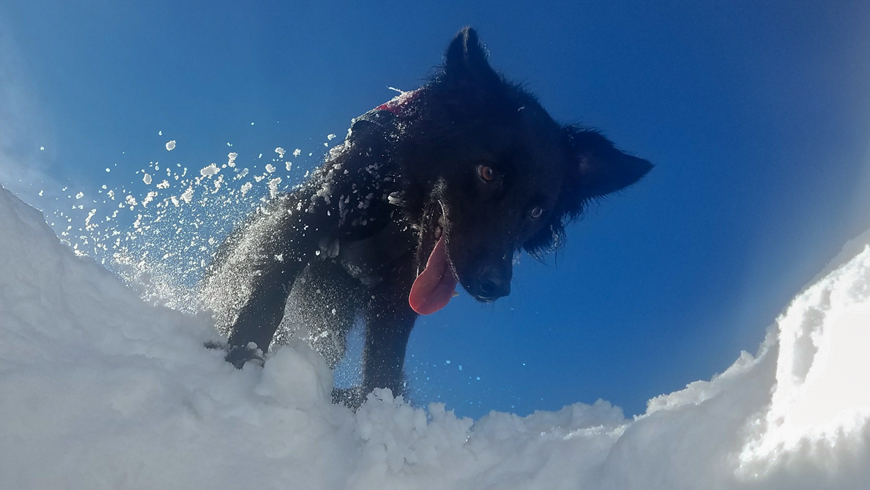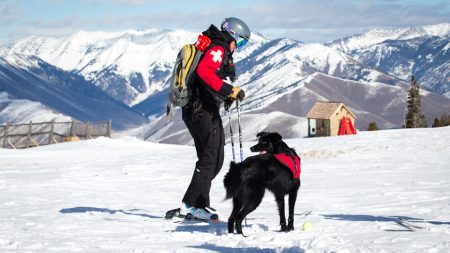The first dog known to officially locate a buried avalanche victim wasn’t exactly trained to do so. In 1938, 18 people were buried in an avalanche referred to as the Schilthorn disaster in the Bernese Alps, Switzerland. Human rescuers found 17 of the victims; a mixed-breed dog that just happened to be accompanying the search party detected the 18th. That dog’s feat was not lost on rescuers. Two years later, the Swiss Army created the first-ever canine avalanche search and rescue (SAR) training program. Soon after that, dogs became an integral part of search and rescue efforts in Europe. However, the use of avalanche SAR dogs in the United States, in organizations like ski patrols, didn’t really become common until about 30 years ago.
“I have worked with Swiss and Canadian dog teams,” said Jake Hutchinson, former vice president of Wasatch Backcountry Rescue and the former director of Ski Patrol and Snow Safety at Canyons Mountain Resort in Park City, Utah. Hutchinson has raised, trained, and run avalanche SAR dogs for 20 years in four states. “I believe that some of the best teams in the world can be found in Utah and Colorado.”
In the early 1990s, some of the bigger ski resorts had one, perhaps two dogs, according to Hutchinson. Now, having search dogs on duty is almost considered standard protocol at major ski resorts. A well-trained avalanche dog is the fastest means—by far—of finding a buried skier not wearing an electronic transceiver (beacon) or a RECCO reflector: a device sewn into ski clothing that reflects a specific electronic signal used by searchers.
And time matters. Studies looking at survival rates of avalanche victims show that if a person survives the initial avalanche and is buried under avalanche debris, the probability of a live recovery drops dramatically after 15 minutes. The nature of the snowpack and the degree of sustained trauma certainly play a role in one’s chances, but the effects are marginal relative to the time factor.
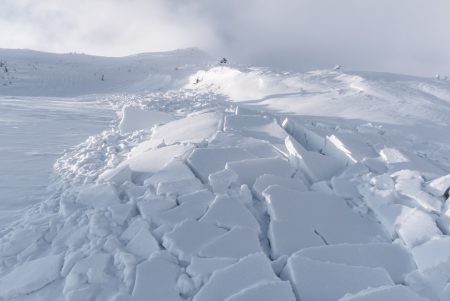
A dog can cover much more ground and faster than a person can, particularly in terrain left by an avalanche.
The fact is a dog can cover much more ground and faster than a person can, particularly in terrain left by an avalanche, which can be strewn with trees, large slabs of hardened snow, boulders, and deep debris piles. What’s more, dogs, with their keen sense of smell—it is approximately 10,000 times more sensitive than a human’s—can detect the scent of victims even if they are buried deep in the snow. To appreciate the scale of this sensitivity, consider an analogy: If we were talking about vision, what a human could see at a hundred yards, a dog could see at over 500 miles away. In her book “Inside of a Dog,” Alexandra Horowitz, a dog-cognition researcher at Barnard College, writes that a dog can sniff out a teaspoon of sugar in a million gallons of water (about two Olympic-size swimming pools).
When former Sun Valley police chief and current evaluator for the National Search Dog Alliance (NSDA), Cameron Daggett, became active with Blaine County SAR in the 1980s, there were no dog teams for any season associated with the county. Daggett had always loved dogs and had trained sled dogs in the 1970s. He recognized a need for dog teams for winter SAR especially.
“You only need to go on a few big avalanche searches to realize how hopeless it is if the missing subject was not wearing a transceiver,” said Daggett. “In the 1980s, most snowmobilers did not wear transceivers and only a few of the backcountry skiers I knew had them.”
Daggett trained his first pup, Oh Boy Roy, an Airedale terrier, in 1990 in the disciplines of avalanche, area search, human remains detection and trailing, so that the pair could work year-round. Soon after, Bruce Smith, a land surveyor and an avalanche consultant with Alpine Enterprises, joined Blaine County SAR with his half-Siberian husky, half-wolf dog named Avy.
“Avy and I had this crazy symbiotic relationship,” recalled Smith. “We knew who was best at what. It [training Avy] was a pretty cool experience. I wouldn’t trade it for anything.”
In the early days of the discipline, the training of avalanche dogs was somewhat of an organic and homegrown process. The handlers read the limited number of books on the subject, and they went to seminars and brought information back to the Wood River Valley where they could set their own standards. Eventually, the group comprised dog handlers from Galena Backcountry Ski Patrol, Sun Valley Ski Patrol, and Blaine County Search and Rescue. In all, there would come to be 14 or 15 teams, each of which comprises a dog and a handler.
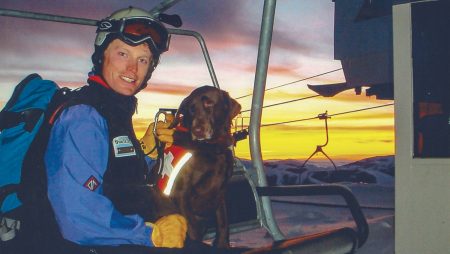
Sun Valley ski patroller Troy Quesnel and his late chocolate Lab, Kintla, who discovered the scent of a missing ski instructor in 2004.
“Dog teams become this close-knit group within a big organization,” Daggett said. “They are always working together because they have to keep the dogs going. It’s an obsessive hobby.”
In the spring of 2000, Sun Valley ski patroller Troy Quesnel carried an 8-week-old chocolate Labrador named Kintla on to Bald Mountain to start socializing with other patrollers and skiers. By that time, many resorts with significant avalanche hazard had started dog programs, but there was still not a lot of information on the best way to train and certify the dogs. Along with the other patrol dog handlers and handlers associated with Blaine County SAR, Quesnel met once a month to brainstorm on ways to set up a certification program in the Wood River Valley. Quesnel and Kintla also learned from and trained with outside organizations like Wasatch Backcountry Rescue. Ultimately, they became the first nationally certified dog team associated with the Sun Valley Ski Patrol. Quesnel and Kintla became a resource not just for the resort but also for the community at large.
“Kintla was a really special animal,” Troy recalled. “She set the bar really high.”
On New Year’s Day 2004, local resident and Sun Valley ski instructor Tomas Wernig went missing while skiing on an uncommonly deep powder day on Bald Mountain. Three days later, it was Kintla that discovered his scent and brought the extensive search to an end.
“When Kintla found Tom on the morning of that third day,” recalled Tim East, a Sun Valley ski patroller who worked as the search coordinator for the incident, “all the Valley dogs were exhausted. We had talked about bringing in dogs from Salt Lake City.”
Quesnel and Kintla’s success sparked an interest in some of the other patrollers, and soon after, more patrol avalanche SAR dogs followed. One of them was East’s dog, Tillie, an energetic black Lab.
“I had no intention of making Tillie an avy dog,” admitted East. “But I would watch her search for a lost ball naturally, and so I called Cam Daggett to train.”
Along with many other obedience sessions, alert drills
and search techniques, they trained using what’s known as the five-hole exercise. In the first stage, with the dog watching, the handler runs away and hides in a snow ditch. When the dog comes to the handler, he or she is rewarded with “play,” whatever that means to the dog: throwing a ball, playing tug-of-war, and generally squealing in high-pitched excitement, much to the dog’s delight.
The second stage is similar except that the handler is lightly buried with snow in a shallow hole or ditch. The third step begins to teach the dog to look for other scents besides its handler’s. A person, generally someone the dog is not too familiar with, will hide in a snow hole with the handler underneath him or her. For the fourth exercise, another person unfamiliar to the dog gets in a hole alone and is lightly covered with snow for the dog to find. All four of these exercises are conducted with the dog able to see what is happening. However, for the fifth and final stage, the handler takes the dog away—out of view of the exercise area—while an unfamiliar person is buried.
After a short amount of time, the handler and dog come back to the scene and begin the search for the buried person or persons.
The five-hole process does not happen in one session, but rather over the course of a season or even a couple of years. And it is just one element to training. What’s more, every dog is individual in personality and temperament, so each team is unique. Yes, there are standards and skills that every team must meet, but as several handlers have been noted as saying, “If there were one way to train, we’d all be doing it.”
During her career, Tillie was involved in two Baldy avalanche events but had to retire due to a blown knee, a common concern for many handlers. “Providing that service to the patrol was rewarding. [Also], you are building a bond that you don’t get with an everyday dog,” East said.
In March 2016, I found myself on the backside of Dollar Mountain bandaging a deep cut on my new puppy’s right front leg. It had been made by my sharp ski edge just four days after my husband and I had adopted a tall, skinny, black-haired, intelligent, but who-knows-what-kind-of-breed named Blaze. “Of course, this would happen,” I said aloud. I was alone, on the clock as a ski patroller, and did not have permission to have my dog with me.
Ever since joining the Sun Valley Ski Patrol two years earlier, I had admired and envied the canine avalanche SAR teams on staff. I could see the possibility of an SAR dog in a smart, light, energetic creature like Blaze. So I snuck him up the Full Dollar chairlift, just to see how he’d do on the snow and around skis. Ironically, the first time I would hoist Blaze onto my shoulders to ski downhill, it would not be to get to a rescue, but rather to rescue him and take care of an injury
I had basically caused.
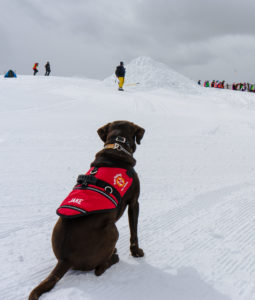
Jake, who belongs to former Ski Patrol Director Mike Lloyd, waits his turn for a search drill.
Blaze spent the first few months in his new home with two layers of stitches, a plastic cone around his head, sedatives, and a very limited schedule of activity to enable his severed tendon to heal. His injury, though frustrating, gave us time to focus on his obedience and attention training, which turned out to be very helpful in the long run.
One of the bigger mistakes that an SAR dog handler can make is to focus on all of the wrong stuff first, according to Hutchinson. Often, there is too much emphasis on “search” because it’s fun. Obedience is equally important and needs to be just as fun.
The three areas of puppyhood development, as any good dog trainer will tell you, are obedience, sociability and play. These elements translate into the three tenets of SAR: search, find, and play. Blaze has “play” down. All Blaze ever wants is play, which works for me. For dogs, searching and finding things is a fun, rewarding game. It has to be.
The following winter, with permission this time, Blaze and I returned to Bald Mountain healed and slightly wiser. He didn’t like snowmobiles, didn’t care for chairlifts and became somewhat catatonic when I skied him down on my shoulders each evening. He terrorized my co-workers, imploring them to constantly throw snowballs for him, and I grew tired of repeatedly calling his name to corral him. But he loved the game, and I loved watching him work. I knew I had to learn his signals: the way his head snaps when he catches a whiff of a human wafting out of the breaks in the snow; how he catches his tongue in his teeth when he’s focused; the way, when he finds someone, he digs with both front paws simultaneously, glancing back at me every so often as if to say, “Am I doing it right?”
While three other ski patrol dog teams and Blaze and I prepared for our certification test last February, we employed the help of our co-workers. This involved asking them to cartoonishly run away in front of the dogs, play with the dogs, and be buried under the snow for the dogs.
“It really does take a team,” Quesnel said. “You can’t do it by yourself.”
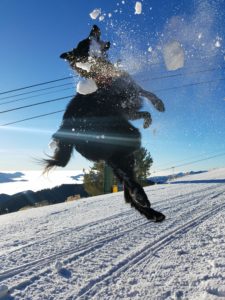
The three tenants of SAR are search, find, and play (Blaze’s favorite).
For each drill I ran over the course of Blaze’s training, I kept meticulous notes: time, date, weather, wind direction, who I had buried, where I had buried them, and how long it had taken for Blaze to find them. As part of the certification process, all of the notes had to be submitted to our examiner.
By the time our certification day rolled around, I was confident but also nervous. Our National Search Dog Association (NSDA) examiner, Scott Quirsfeld, came to us from Mammoth Mountain, Calif., where he is the ski patrol manager. When asked what he was looking for in terms of mechanics of the search, he answered: “For the human to size up the scene, develop a search strategy using wind direction, terrain, and accessibility for starters. Then relay those by voice, body language or physically moving alongside them.”
Six dog teams were to be certified or re-certified that day; I drew the shortest straw and had to go last. We had not been allowed near the testing site all day for fear of contaminating the scene with our scents. I did, however, know that we would be looking for multiple burials and would have to bypass empty holes that had already been used, as well as clothes and equipment that had been discarded by the “victims” or by the search party. In the end, I just let Blaze work and read his alerts correctly. We passed the test without a hitch. Obedience we’re still working on.
This winter, Blaze and I will officially join the list of dog teams that train for and serve both the Sun Valley Ski Patrol and Blaine County at large. While writing this article, I asked each of my interviewees what the ideal dog team looks like. Each answered with a common theme: through all of the training, good weather and bad, ice and powder, and the literal bells and whistles, there must be trust, fairness, love, and devotion on both sides.
I look at Blaze, and my heart swells at his bright inquisitive eyes, his fluffy ears, and his lolling tongue. I love this dog. I trust this dog. I can work with this dog.


